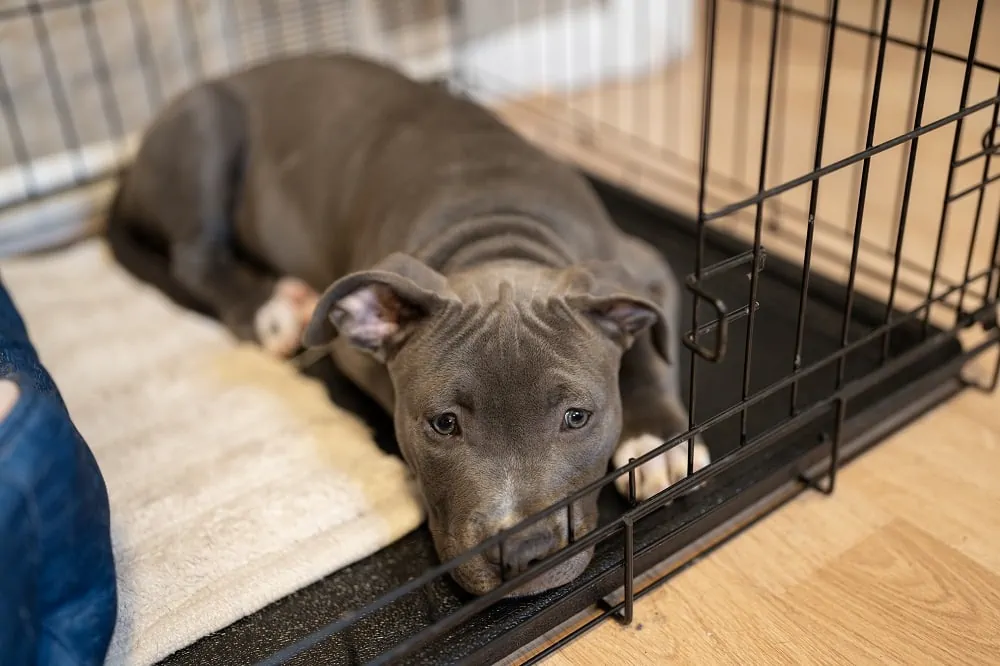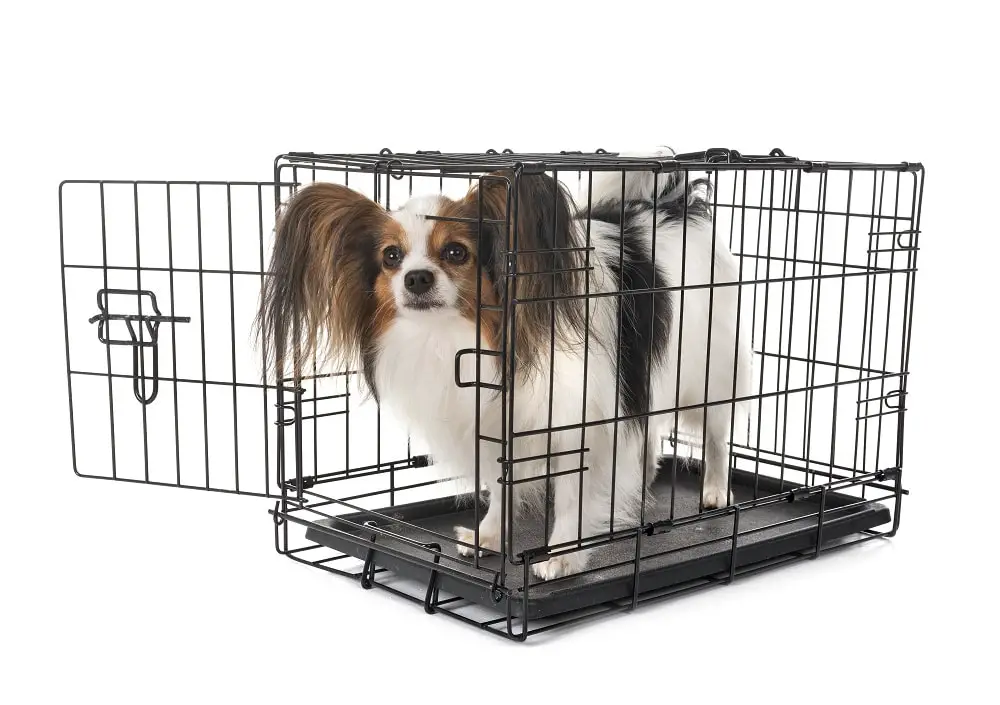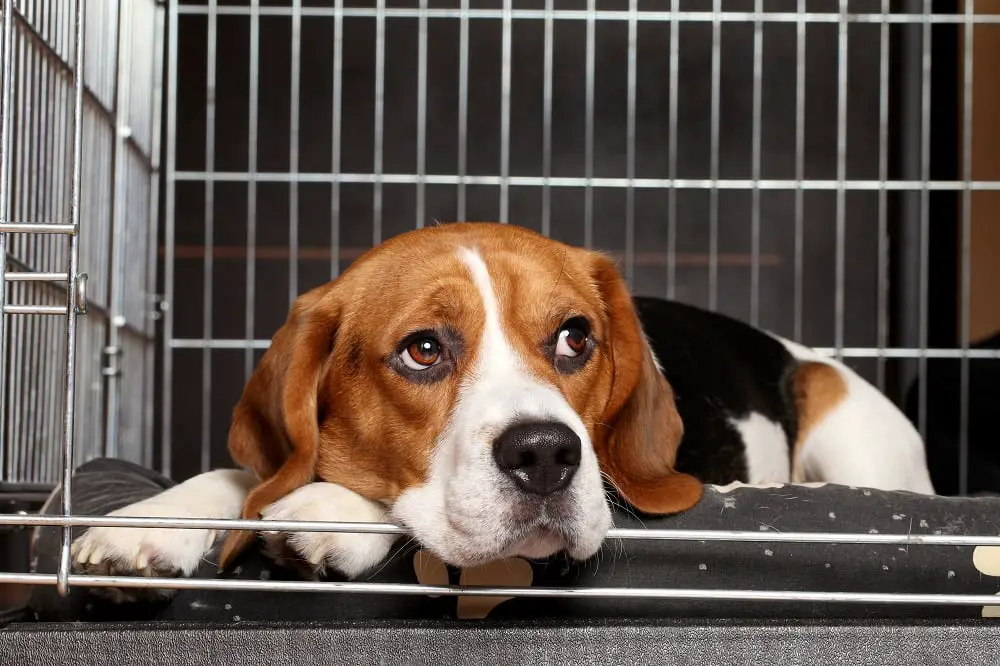Introduction
While most people looking to adopt a pet are likely to set their sights on a puppy or a kitten, there are times when an older dog (or cat) comes into your life.
Is it possible to crate train an older dog? Yes, it is possible to crate train an older dog. The process and procedures for training an older pet are pretty much the same as for house-training a puppy – with one or two important concessions to age.
Is the process of integrating an older animal into your household any different to house-training a new-born? This article focuses on how to crate train an older dog.
Classical Conditioning

Anyone who has studied a bit of psychology will immediately recognize that animal training owes a lot – well, almost everything – to the early behaviorist school of thought in the human sciences.
Many will argue that the relationship is the other way around and that psychologists like JB Watson (1925) used animal behavior studies as a means of explaining – and shaping – human behavior (source).
In behaviorist terms, all that matters when it comes to explaining why we (and animals) behave as we do is the relationship between behavior (or responses) linked to events in the environment (stimuli).
The behavior of humans and animals is merely a function of environmental events. This can be depicted simply as follows:
This is the basis of all animal training. In terms of trying to explain human behavior, these ideas reached their zenith in the early 1970s with BF Skinner’s Behaviorist school.
However, the extension of behaviorist principles to human behavior has long been seen as too simplistic to explain the complexity of human responses.
But as we shall see, the principles remain firmly in place when it comes to animal training. They can apply to crate training an older dog or teaching a dog to stay.
These applications started perhaps in the 1920s with Pavlov and his famous dog who was taught to salivate in response to the turning on of light – or in some accounts, the ringing of a bell.
The linking of a stimulus (a ringing bell, for example) to a response (e.g., salivation) became known as a “conditioned response”.
In classical behaviorist terminology, much of our animal training today is based on the association of an “unconditioned stimulus”, e.g. a doggy treats, to an “unconditioned response”, e.g. relaxed enclosure in a crate.
Through the association of the treatment with the crate over time, the verbal command to your dog to settle into the crate becomes a “conditioned response”, and no longer requires the treatment to be given every time.
Is There A Difference Between Puppy and Dog Training?
So, what is the essential difference between crate training a puppy and an older dog? There are three – or four – things that spring to mind:
1. Older dogs may have to change ingrown habits
2. Older dogs may come from a ‘disadvantaged’ background
3. Crate training an older dog may take longer
4. You CAN teach an old dog new tricks
What’s the Difference Between A Crate and A Kennel?
Let’s get one thing straight. A crate is not the same as a kennel, and they really do perform different functions and serve different purposes.
Most importantly – and obviously – a kennel allows your dog freedom of entry and exit, to come and go as he pleases. A crate, on the other hand, has a door or gate which can be closed and secured (source).
There is something of a myth surrounding the need that many animals, including dogs, are said to have for a “den” in order to make them feel safe and secure.
Dogs can be made to feel safe and secure in any environment, with or without a den. There are some owners, however, who feel that providing a safe place for your dog to chill out, nap, get away from the kids, or whatever is a “good thing”.
This may well be the case and is one of the main reasons for crate training your dog in the first place: to provide a place where they can feel safe and secure in familiar surroundings.
There are other differences between a crate and a kennel, apart from the gate. Physical size is one. A kennel is often bigger, heavier, and not designed for transport or mobility.
It is more often than not located in the yard and may or may not be the designated sleeping place for your dog, depending on such factors like the weather and whether or not your yard is fenced and gated.
Conversely, a crate is designed to travel and as such is smaller and lighter than your standard kennel. The crate is also suitable – in terms of size and aesthetics – to be accommodated indoors, which makes it far more suitable for training purposes. Which brings us to the question:
Why Crate in The First Place?
There are a number of reasons:
Your dog will probably have to travel at some points in his life. Whether to the vet, the grooming parlor, or relocation to a new neighborhood, if your dog can travel in a closed environment with which they are already long-familiar, the experience of travel – often upsetting for some dogs – will be made easier.
Learning the rules of their new home is another reason to crate. Although most older dogs are already house-trained, a new environment may require fresh training in where and when to go to the toilet, and where and when not to.
Since most dogs will not soil their sleeping place – and have already learned to control their bowels over a reasonable period of time – confinement in a crate is one way to facilitate house-training.
There may be other animals already resident, and a period of adaptation is needed. Again, a crate is an ideal way in which to allow the new houseguest to get to know each other while providing a safe retreat for the new dog to view his surroundings and get to know the sounds and smells and routines of his new home.
Where Do We Start with The Crate Training?
Firstly, selecting the right-sized crate is important. It should be of a size suitable for your dog to be able to stand up in, turn around, and stretch out when sleeping.
It should also be big enough to accommodate the dog when fully grown, so as to save the inconvenience and expense of having to replace the crate as the dog grows. But we’re talking here about a fully-grown dog, anyway, so just make sure the crate is big enough (source).
But: not so big that the dog has room to make a toilet at one end of the crate while sleeping at the other end. Remember we said that most dogs usually won’t soil their sleeping place?
Allowing your dog to soil the crate will largely defeat one of the purposes of crate training in the first place. So, ask your pet-store owner’s advice on the best-sized crate for your dog.
Secondly, make the crate comfortable. If your dog already has a favorite blanket or bedding, place this in the crate.
For many older dogs, this will be enough to encourage them to start using the crate straight away – after a little nosing around, perhaps.
Although we’ve remarked that dogs don’t naturally seek out a “den”, there is some anecdotal evidence that they do develop favorite resting places.
Here they can escape from the disturbance of other householders – especially boisterous puppies, annoying felines and rowdy children – to nap during the day, something which is important and necessary to the older dog.
So, let’s start with the training. Note that – pretty much like us humans – every dog is different, with a different personality, likes and dislikes.
You’ll need to monitor your dog’s reactions to all of these steps along the way and adjust your training accordingly (source).
Step 1:
Take it slowly. This applies to train your pup, too, but pups don’t come with any baggage and – assuming they’re normal, well-adjusted puppies – are usually eager and willing to “lap up” any training you may provide.
This is especially true if the training comes with treats and tasty rewards, or if it becomes a game between the pup and her favorite playmate – you.
These principles incorporating treats and game-playing apply equally to an older dog, except that the older dog may be warier of your motives and intentions, especially if they’re a rescue who comes from a background where there has been abuse or neglect.
A dog who has a history of being caged or harnessed in a yard all day, for example, is far less likely to willingly investigate the inside of a crate.
This stage requires great patience on your part, and for an older dog with some prior issues, you may take anything from weeks to months. So, where do we start?
Step 2:
Assuming that you’ve created a welcoming environment inside the crate, start by thinking of where the crate is placed in the home.
You’ll want to place it in an area of fairly high traffic where the dog will come across it during times of investigating his new surroundings.
Being naturally inquisitive, most dogs will sniff around the crate and – if there’s the familiar smell of bedding – will likely settle in sooner or later.
Placing a treat in the near vicinity or just inside the crate may further invite the dog to see this as a welcoming place.
If this doesn’t work, feeding your dog in the near vicinity of the crate, and gradually moving feeding to inside the crate, will start to develop the association between something pleasant (food) and this cage-thing in the corner of the living room.
Remember our introduction to stimulus-response theory and classical conditioning? That’s what we’re doing here: providing a link between something desirable (food, treats) with the conditioned response of entering and staying in the crate.
When that association is established, the stimulus (food, treats) can easily be removed, with only the occasional reinforcement – if ever.
Remember, too, that verbal reinforcement – praise and encouragement from you – is just as important as any yummy treats.
Step 3:
Of course, throughout this preliminary training period, the gate of the crate has been open. It will remain open even when the dog first ventures into the crate, and for a time thereafter until he is comfortable to lie down and nap in the crate.
Obviously, the crate must never be associated with a “time-out” type of punishment. Nor should it be used as a means of isolating your dog from social interaction; for example, when you have people around.
This may well be one of the benefits of crate training – providing your dog with a refuge if there are little kids around, or other strange dogs, or guests who are allergic to dog hair, or whatever – but the crate must never be seen as a prison. It’s his safe-space, and your dog must know this.
Step 4:
Associate going to the crate with a command. Just as your dog will learn soon enough to respond to other commands – one of the first being “Walkies!” – so you should teach them a command to go to their crate.
This could be anything appropriate such as “In your Box!” or “Crate!” and will be trained in much the same way as before: by associating the desired behavior with a reward or treat (source).
For a quick guide, check out this video below:
Things to Watch Out For
Just as you should never use the crate as a punishment or prison, so should you never crate your dog for longer than is absolutely necessary. How long is that?
Age has something to do with it, in that an older dog is more able to control their bowels than a puppy.
Even then, all animals require regular and frequent exercise and social interaction, so crating your dog for the day while you’re at work, and then again for the night while you sleep is clearly a recipe for one depressed animal. Who would want to do this to their pet?
There is a rule of thumb that says that one can crate a puppy for up to an hour for each month of age, plus one.
So, a six-month-old puppy can – in theory – be crated for up to seven daytime hours, plus potty breaks. But this sounds excessive, especially if it happens on a regular basis, such as every weekday.
No dog should be crated regularly for longer than eight hours at a stretch unless this is overnight. Even then, if there are toilet “accidents”, more regular toilet breaks should be allowed.
Remember, too, that bowel control gradually weakens with age, so older dogs should be allowed more regular toilet breaks from their crate.
In any event, much shorter crating periods should be a feature of early crate training so that your dog does not come to associate the crate with punishment and social isolation.
After all, if your dog is going to be shut up in a crate for the majority of his day – and possibly his nights, too – why are you even keeping a dog in the first place?
Oh, and don’t forget to remove your dog’s collar when crated. You don’t want to find the collar the next morning snagged to one of the bars… with Rover still attached.
The Case for Crate Training

With proper and considerate training, a crate can become the preferred “go-to” sanctuary for any dog in the home. If training is positive and slow-paced to meet your dog’s needs, a crate is a secure and safe environment for both the dog and to protect other members of the household.
Crate training removes much of the possible trauma associated with travel over short or long distances. Crating is an increasingly required form of containment for many forms of travel.
It is a much safer and more secure option than on a harness or leash, which is unsuitable and inappropriate for many forms of travel (source).
The Case Against Crate Training
Crates may be viewed by some as a cruel and unnecessary form of containment. The dog’s movements are restricted to standing up, turning around and lying down.
Depending on where the crate is placed in the home, its design and size, and if the side flaps are secured, the crate may be poorly ventilated and claustrophobic for the dog.
If exercise and social interaction are limited, there is a real threat of the dog becoming stressed, depressed or aggressive. None of these scenarios are in the best interests of the dog.
Final Thoughts
Just like old people, an old dog may find it difficult to learn and remember new routines. Crate training an old dog with dementia or with a history of neglect, from scratch, may just be a step too far.
For the majority of dogs, however, crate training is not only possible but also desirable for your peace of mind and for the dog’s safety and well-being.
And, apart from a little more time and patience, the process of crate training an older dog is identical to training a puppy.


0 Comments